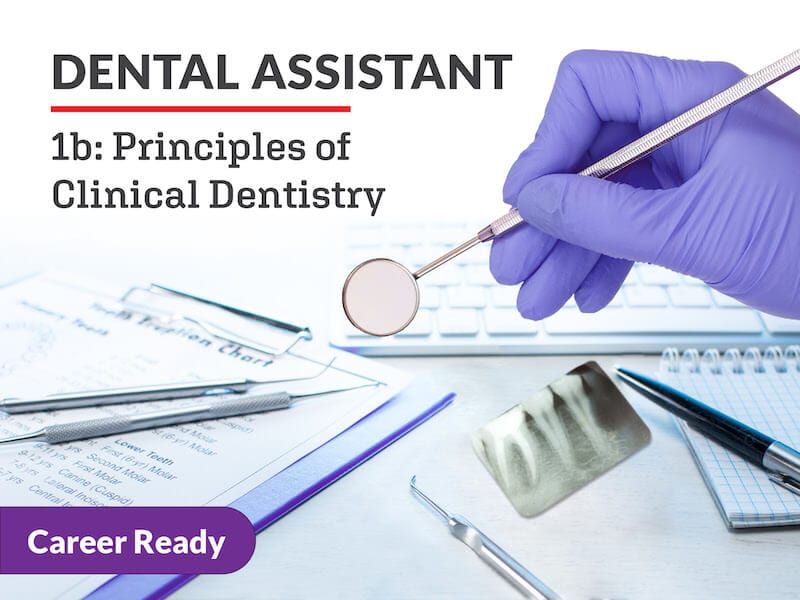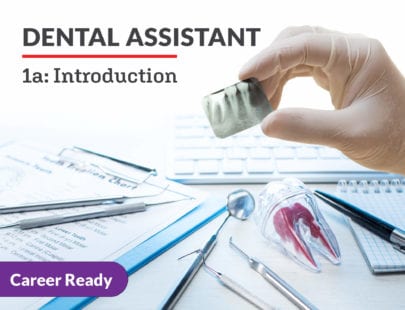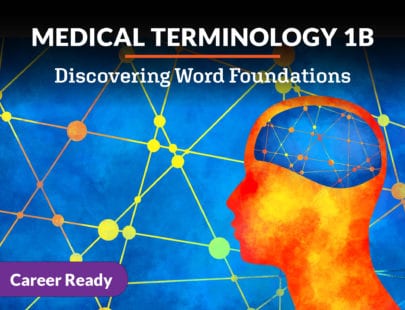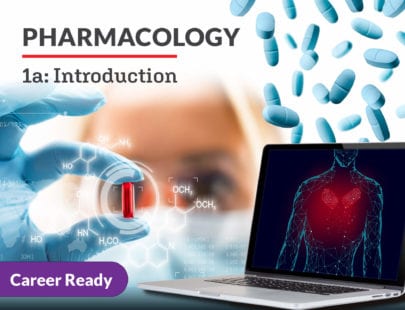
Dental Assistant 1b: Principles of Clinical Dentistry
You have scraped the surface of how rewarding assistant dentistry can be, and now it’s time to drill deeper into the inner-workings of the role. In Dental Assistant 1b: Principles of Clinical Dentistry, you’ll learn about the daily duties of a dental assistant including the structure of an office visit, managing patient records, and administrative aspects of the role. You’ll also explore how patient health can impact oral health, how to prepare for and perform a patient visit, and how to succeed in a team environment. Let’s continue polishing those skills to become a dental assistant today!
Units at a Glance
Unit 1: Dental Caries and Nutrition
One of the leading health concerns worldwide is the infectious disease known as dental caries. You are probably familiar with the name it’s more commonly known as: dental cavities. Though it can affect people of all ages, tooth decay is more typically found in children; it is the most common preventable infectious disease found around the globe. One excellent defense to fighting this disease is regular tooth brushing, but did you know that nutrition also plays a vital role in caries prevention? Eating a well-balanced diet is an essential part of maintaining your oral health and helping you avoid the need for restorative work in the future. Let’s learn more about dental caries and the role diet plays in your dental health.
What will you learn in this unit?
- Classify dental caries as an infectious disease and name the types of bacteria that cause dental caries
- Explain the caries process, including how dental caries is transmitted, and list common caries interventions
- Analyze the six areas of the food pyramid
- Discuss how diet, nutrition, and eating disorders can affect oral conditions
Unit 2: Preventive Dentistry
Many years ago, dentistry simply focused on fixing the problem when a patient came into the office in pain, as opposed to warding off future troubles. Today we focus on educating patients so that we can prevent disease and pain from developing in the first place. This holistic approach includes regular check-ups and fostering good home care habits such as brushing and flossing. Creating and supporting these habits will lead to good oral hygiene and an overall improvement in patients’ health and wellbeing. As dental assistants often take a frontline role in patient education, let’s learn more about the foundations of preventive dentistry care.
What will you learn in this unit?
- Discuss the benefits of early dental care including during pregnancy, infancy, and early childhood
- Describe how fluoride works
- List available oral hygiene products that help with plaque control
- Explain the goal of preventive dentistry
- Identify the roles of coronal polishing and dental sealants in preventative dentistry and explain the steps necessary to perform them
- Summarize the importance of periodontal maintenance and evaluate patients’ risk factors for the disease
Unit 3: Treatment Planning and Charting a Diagnosis
While dental assistants have many responsibilities in terms of working directly with patients, there are also quite a few behind-the-scenes pieces to keep situated. Once a patient chart is started, there are a number of things that need to be updated and kept accurate. Not only must information be entered, but it must be done in an appropriate manner that will allow others in the office to quickly evaluate what they need to know about any given patient. Learning the appropriate way to maintain charts is one of a dental assistant’s main responsibilities and key to delivering the highest standard of care and best possible treatment options.
What will you learn in this unit?
- Update a medical history and dental history
- Identify and use the abbreviations and symbols commonly required in charting oral conditions
- Assist with a patient’s clinical exam and in explaining treatment plan options
- Demonstrate how to maintain various office records
Unit 4: Administrative Responsibilities
Although the business assistant doesn’t work directly with the patient in the operatory, they have just as many responsibilities as the clinical assistant. Depending on the size of the office, these responsibilities may be divided amongst several people, or there may be one individual who’s in charge of it all. Though additional work obligations may vary from practice to practice, in general the business assistant is responsible for greeting patients, talking on the telephone, scheduling appointments, processing insurance claims, and managing inventory. It’s an important role in any dental practice and is often one that is crucial to the overall success of the group.
What will you learn in this unit?
- Understand the layout of a typical dental office and how it can best serve its patients
- Describe the importance of communicating effectively with patients and dental professionals
- Outline the process for scheduling appointments, including units of time
- Explain the purpose behind the dental recall system and how it can be successfully utilized and implemented
- Recognize how dental insurance can assist patients and how to manage insurance paperwork within dental practice
- Process and maintain inventory control systems
Unit 5: Dental Equipment and Maintenance
There are many pieces of equipment in any medical facility, and the dental office is no exception to that rule. Dental equipment is an important part of the dental office. This equipment is expensive machinery and encompasses a wide variety of functions. It can be delicate and must be properly taken care of to prolong its lifespan. Each piece must be maintained according to the laws in place as well as the manufacturer’s instructions. Though it is primarily the clinical dental assistant that may be responsible for the routine care of equipment, learning more about the maintenance and upkeep of these important tools and machines is valuable information for all dental assistants.
What will you learn in this unit?
- Name the dental equipment found in a dental office
- Describe proper use and maintenance of clinical equipment
- Explain the care involved with dental equipment
- Identify instruments and describe their functions for general dental procedures
- Explore the tools typically used by the dental hygienist during preventative procedures
- Understand the function of common pieces of laboratory equipment
Unit 6: Basic Chairside Procedures
Although the specifics of a tray set up or a procedure may vary from office to office, there are some helpful basic guidelines to keep in mind. Once a dental assistant settles into a position in a dental practice, they can then expand on these basic skills. Some of the standard procedures include preparing a treatment room, basic tray set up, taking vital signs, and using the suction tip during procedures. Being able to independently complete these tasks is a strong foundation for a clinical dental assistant.
What will you learn in this unit?
- Demonstrate proper posture and the neutral working position and identify guidelines for reaching movements
- Understand the basics of delivering dental care and the classification of motions
- Define the operating zones and appropriate ways to grasp and transfer instruments
- Discuss oral evacuation systems and their purposes
Unit 7: General Dentistry I
General dentistry is a dynamic field that is always changing to match the evolution of technology as it becomes available. While general dentistry does not have a specialty, it focuses on all major aspects of oral health and can include amalgam restorations, intermediate restorations, crowns, bridges, and dentures. Another name for the work done by a general dentist is restorative dentistry. As the dental assistant must have background knowledge in restorative procedures to practice four-handed dentistry and appropriately assist the dentist, they must also be prepared to grow and learn in this field as well.
What will you learn in this unit?
- List the educational requirements to become a board-certified general dentist
- Identify reasons for restorative and esthetic dental treatment
- Name the types of esthetic dental procedures
- Discuss the role of the dental assistant during dental procedures
- Prepare tray setups for a variety of dental procedures
Unit 8: General Dentistry II
General dentistry consists of procedures from other specialties. Being a general dental assistant therefore requires the ability to know all the instruments as well as specific materials used throughout all procedures. These procedures range from simple Class I fillings to more complex multi-unit bridge preparations and can include in-office or take-home whitening procedures. These procedures are likely completed using four-handed dentistry for easy transitions between instruments and to help save time while mixing dental materials. Here, we’ll learn how to apply all of this knowledge on a regular basis to best meet the needs of the dental practice and of course, your patients!
What will you learn in this unit?
- Describe the types of matrix systems, including the purpose of a wedge
- Know proper sequence of Class II amalgam restorations to anticipate the dentist’s needs during patient treatment and provide appropriate post-operative instructions
- Know proper sequence of Class III or IV composite resin restorations to anticipate the dentist’s needs during patient treatment and provide appropriate post-operative instructions
- Know proper sequence of crown or bridge restorations to anticipate the dentist’s needs during patient treatment and prepare a dental laboratory script for a direct restoration or prosthetic case
- Outline treatment options for vital bleaching
Required Materials
Physical
- Video recording device
- Printer
- Folders
- Camera phone
- Colored pencils
- Audio recording device
Software
- Word processing software
- Presentation software
Optional
- Posterboard and markers
- Printed images
- Digital images of oral cancer
- Graphic design software
- Spreadsheet software
- Paper and colored pencils


